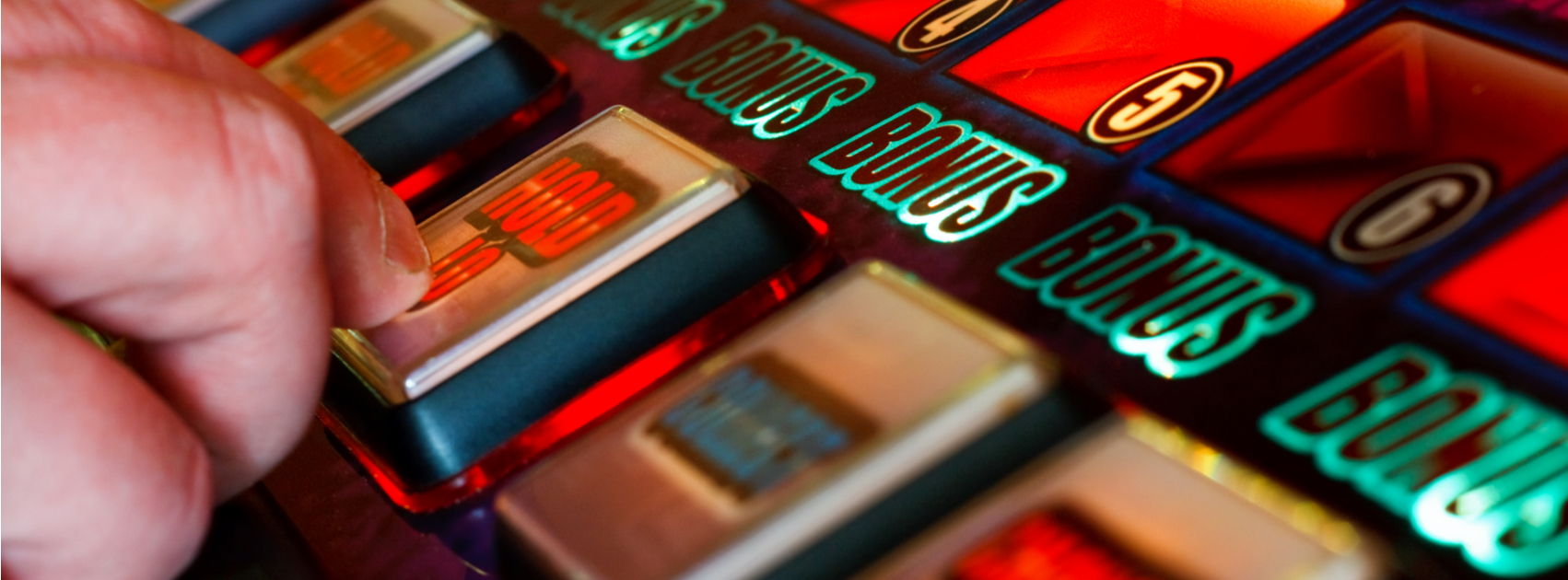
Fruit machines are pretty sophisticated these days. They are specifically designed so they can’t be “gamed” and are rigorously tested to be tamper-proof. However, there are always people out there who think they can rip off a fruit machine, at the cost to your venue.
How fruit machines work
Before you can understand how people exploit fruit machines, it’s useful to understand how they work. The appeal of fruit machines lies in the fact that anyone can win at any time. All it takes is a real money wager and a click, and a massive jackpot prize could be yours to enjoy.
When you pop in a coin, the coin is validated by a carefully calibrated detection system that confirms the coin is valid. Invalid coins simply fall straight through. Valid coins land in a hopper (formerly a system of tubes) and add to the fruit machine’s “float”. When a winning spin lands, the machine dispenses the allocated amount from the hopper.
Behind the scenes, fruit machines are anything but simple. In fact, the technological innovations in fruit machines represent some of the most advanced technology in the gaming market. The key to a fruit machine lies in its RNG, or random number generator.
Simply put, a random number generator is a highly complex software program that randomises all outcomes to ensure that every spin generates a result that is independent of the previous spin in every way. Simulating randomness in a man-made creation is a serious challenge, but to the player, the world’s leading software providers and gaming developers have perfected this.
Remember, RNGs are simulated randomness. This will become important later.
Each slot machine has a certain number of spinning reels and a certain number of symbols. There are also a certain number of paylines, sometimes they are fixed and sometimes they are not. For each reel, the random number generator will select a random number which is associated with the symbol. This results in a huge number of variations in each fruit machine spin.
By the time you have deposited coins in the slot, the random number generator has already determined the outcomes. What you see playing out in front of you is merely for entertainment purposes only. Sorry to disappoint you, but the cherries don’t actually mean anything!
Here’s how people exploited them
Back in the day, fruit machines were much easier to cheat. From their physical construction to their software, fruit machines used to be quite vulnerable to cunning fraudsters.
Not that many years ago, fruit machines would use a coin tube and a solenoid as the way to payout winning players. With the simple application of a drill, fraudsters could rinse a machine with ease.
When a coin was inserted into the coin slot and validated, it would roll down a chute, which passed over a long plastic tube. If that tube was full of coins then the coin would pass over the top of it and fall into the cash box located at the bottom of the fruit machine.
That tube held the float of a fruit machine and whenever a player won, the CPU would send a set number of pulses to the solenoid located at the bottom of the tube, which would then move forward and backwards the required number of times.
Attached to that solenoid was a small plastic plunger which would be located at the bottom of the tube and each time it moved backwards and then forwards one coin would be dispensed, and that is how the fruit machine would pay out winning players.

Fraudsters realised that by getting hold of a small cordless drill, they could drill a hole in the side of the fruit machine, which are usually always made of wood, and manipulate the plunger, forcing coins to drop.
What the slot cheat would do is insert a small rod, or a screw driver into the hole and force the plunger backwards and forward rapidly by hand. Each time you push the plunger, you get a coin. Experienced “rodders”, as they became known, could empty a slot machine of all of its coins in a minute or so.
To tackle this problem, modern fruit machines use hoppers, rather than tubes. This way, you can’t just manipulate a plunger to drop coins.
Another way of exploiting fruit machines is to find a way to manipulate the RNG. In June 2014, the Lumiere Place Casino in St Louis, USA noticed an anomaly with their slot machine. Despite not awarding any major jackpots, a number of their machines paid out over the odds, to the tune of $21,000 in total. The exploit was traced to a Russian, named Murat Bliev, who had cracked the RNG algorithm on an Aristrocrat Mark IV model slot machine.
But how did he do it?
In 2009 Russia outlawed almost all gambling. At the time, it was claimed that this would help cripple the income and influence of Georgian organised crime, who used gambling, especially slot machines, as a way to generate revenue and launder cash.
Forced with the need to offload their machines fast, casinos and bookies sold their machines to anyone who would buy them. This included fraudsters and counterfeiters, who were keen to explore the slot machine source code. The source code (the nuts and bolts of how the RNG software works) can reveal potential vulnerabilities to those clever enough to find them.
Remember what we said about RNGs earlier? They cracked the simulated randomness.
RNGs aren’t really random. RNGs are created using coded instructions, and while bafflingly complex in their design, they aren’t truly random. RNGs take an initial number, known as a seed, and then alter it together with various hidden and shifting inputs. This can range from the time from a machine’s internal clock, to the pattern of lights illuminated at certain times, in order to produce a result that appears impossible to predict.
But if you knew the variables, all the elements that make up the RNG, you can potentially predict the output. And Bliev did just that. By recording a few spins of the machine, he and his cohorts could determine the results of particular spins to game the machine into landing on winning reels.
Murat Bliev and his gang were caught, but not before rinsing America and Europe of hundreds of machines. Since then, the Aristrocrat Mark IV model slot machine was recalled and manufacturers have taken even further steps to keep their machines secure.
Spotting Fruit Machine Cheats
Big and obvious exploits are taken care of by the fruit machine’s design. Exploits like the one Bliev and Co found, if they are ever found, are quickly changed by the manufacturers to protect their machines and their customers.
But despite the security, there is always a chance, as with anything, a new cheat is discovered. This is why, despite all their locks and vaults, banks have security personnel too. This is because vigilance is key.
Position your fruit machines within clear view of both your staff and your CCTV. Watch for patterns among your players. If the same people come in at the same times and win, that’s a red flag that they may have discovered a new cheat. If they appear to play in an unusual way, keep an eye on their behaviour.

Also, be mindful of large groups clustering around your machines. They may be shielding people from physically manipulating the machines to get at the cash inside.
Keep your staff well advised as to whether visitors or repairmen are due to service the fruit machines when they are on shift. Only allow your approved fruit machine supplier to access your machines.
Today’s fruit machines are a secure and valuable revenue stream to many pubs and clubs in the UK. They provide entertainment to patrons and help create a fun and pleasurable atmosphere. Help keep your revenue stream safe by being vigilant, keeping your fruit machines close to the bar and making sure your staff are informed and educated.





Comments are closed.